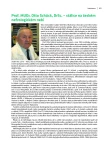-
Medical journals
- Career
Chronic dysfunction of a transplanted kidney:
the problem still unresolved
Authors: Ondřej Viklický
Authors‘ workplace: Klinika nefrologie, Transplantcentrum IKEM, Praha
Published in: Vnitř Lék 2016; 62(Suppl 6): 102-105
Category: Reviews
Overview
Kidney transplantation represents the best treatment of end stage renal diseases in respect of patient survival and quality of life. Despite many advances in immunosuppression and surgical techniques, many kidney grafts are being lost in the long term, mainly due to chronic rejection and recurrence of glomerulonephritis. Calcineurin drug nephrotoxicity, which was overestimated in last decades, seems to have only minor impact on graft survival if any. Despite better understanding of mechanisms of kidney graft injuries, which are reflected by never-ending changes in histological classification systems, optimal treatment strategies are not available for majority of cases. Prospective randomized trials generated from transplant community are therefore warranted to solve many questions about the therapy.
Key words:
chronic rejection – kidney transplantation – nephrotoxicity – recurrence
Sources
1. Solez K, Axelsen RA, Benediktsson H et al. International standardization of criteria for the histologic diagnosis of renal allograft rejection: the Banff working classification of kidney transplant pathology. Kidney Int 1993; 44(2): 411–422.
2. Solez K, Colvin RB, Racusen LC et al. Banff ´05 meeting report: Differential diagnosis of chronic allograft injury and elimination of chronic allograft nephropathy („CAN“). Am J Transplant 2007; 7(3): 518–526.
3. Haas M, Sis B, Racusen LC et al. Banff meeting report writing committee. Banff 2013 meeting report: inclusion of c4d-negative antibody-mediated rejection and antibody-associated arterial lesions. Am J Transplant 2014; 14(2): 272–283. Dostupné z DOI: <http://dx.doi.org/10.1111/ajt.12590>.
4. Feucht HE, Schneeberger H, Hillebrand G et al. Capillary deposition of C4d complement fragment and early renal graft loss. Kidney Int 1993; 43(6): 1333–1338.
5. Tait BD, Süsal C, Gebel HM et al. Consensus guidelines on the testing and clinical management issues associated with HLA and non-HLA antibodies in transplantation. Transplantation 2013; 95(1): 19–47. Dostupné z DOI: <http://dx.doi.org/10.1097/TP.0b013e31827a19cc>.
6. Matl I, Hribova P, Honsova E et al. Potential predictive markers in protocol biopsies for premature renal graft loss. Kidney Blood Press Res 2010; 33(1): 7–14. Dostupné z DOI: <http://dx.doi.org/10.1159/000275705>.
7. Pascual J, Pérez-Sáez MJ, Mir M et al. Chronic renal allograft injury: early detection, accurate diagnosis and management. Transplant Rev (Orlando) 2012; 26(4): 280–290. Dostupné z DOI: <http://dx.doi.org/10.1016/j.trre.2012.07.002>.
8. Eskandary F, Bond G, Regele H et al. Late Antibody-Mediated Rejection in a Large Prospective Cross-Sectional Study of Kidney Allograft Recipients – Preliminary Results of the Screening Phase of the BORTEJECT Trial. Clin Transpl 2014 : 189–195.
9. Canaud G, Delville M, Legendre C. Recurrence of Focal and Segmental Glomerulosclerosis After Transplantation. Transplantation 2016; 100(2): 284–287. Dostupné z DOI: <http://dx.doi.org/10.1097/TP.0000000000000902>.
10. Barbour S, Gill JS. Advances in the understanding of complement mediated glomerular disease: implications for recurrence in the transplant setting. Am J Transplant 2015; 15(2): 312–319. Dostupné z DOI: <http://dx.doi.org/10.1111/ajt.13042>.
11. Clayton P, McDonald S, Chadban S. Steroids and recurrent IgA nephropathy after kidney transplantation. Am J Transplant 2011; 11(8): 1645–1649. Dostupné z DOI: <http://dx.doi.org/10.1111/j.1600–6143.2011.03667.x>.
12. Ekberg H, Tedesco-Silva H, Demirbas A et al. [ELITE-Symphony Study]. Reduced exposure to calcineurin inhibitors in renal transplantation. N Engl J Med 2007; 357(25): 2562–2575.
13. Schena FP, Pascoe MD, Alberu J et al. [Sirolimus CONVERT Trial Study Group]. Conversion from calcineurin inhibitors to sirolimus maintenance therapy in renal allograft recipients: 24-month efficacy and safety results from the CONVERT trial. Transplantation 2009; 87(2): 233–242. Dostupné z DOI: <http://dx.doi.org/10.1097/TP.0b013e3181927a41>.
14. Liefeldt L, Brakemeier S, Glander P et al. Donor-specific HLA antibodies in a cohort comparing everolimus with cyclosporine after kidney transplantation. Am J Transplant 2012; 12(5): 1192–1198. Dostupné z DOI: <http://dx.doi.org/10.1111/j.1600–6143.2011.03961.x>.
15. Gaston RS, Cecka JM, Kasiske BL et al. Evidence for antibody-mediated injury as a major determinant of late kidney allograft failure. Transplantation 2010; 90(1): 68–74. Dostupné z DOI: <http://dx.doi.org/10.1097/TP.0b013e3181e065de>.
Labels
Diabetology Endocrinology Internal medicine
Article was published inInternal Medicine

2016 Issue Suppl 6-
All articles in this issue
- Bioimpedometry and its utilization in dialysis therapy
- The results of SPRINT study from the point of nephrology
- Systemic and intraperitoneal inflammation in peritoneal dialysis patients
- Utilisation of salivary markers in nephrology
- IgA nephropathy – research-generated questions
- Gitelman´s syndrome as common cause of hypokalemia and hypomagnesemia
- Osteoporosis – epidemiology and pathogenesis
- Suplemented restricted diet in old patients with chronic renal disease
- Current options of treatment of hyponatremia
-
Chronic dysfunction of a transplanted kidney:
the problem still unresolved - Present possibilities of monitoring the effectiveness of hyponatremia therapy
- Theralite and multiple myeloma
- [Na+] – [Cl-] difference significantly contributes to acidemia in patients with liver cirrhosis
- Prevalence of microalbuminuria in patients with diabetes mellitus in the Czech Republic: Project IDN-Micro
- Plasma and salivary markers of oxidative and carbonyl stress in patients with acute intermittent porphyria
- Metabolic acidosis in chronic kidney disease
- Vitamin D3 supplementation and cellular calcium homeostasis in patients with chronic kidney disease
- Internal Medicine
- Journal archive
- Current issue
- Online only
- About the journal
Most read in this issue- Metabolic acidosis in chronic kidney disease
- Current options of treatment of hyponatremia
- Gitelman´s syndrome as common cause of hypokalemia and hypomagnesemia
- Osteoporosis – epidemiology and pathogenesis
Login#ADS_BOTTOM_SCRIPTS#Forgotten passwordEnter the email address that you registered with. We will send you instructions on how to set a new password.
- Career

